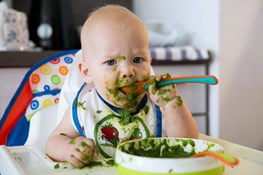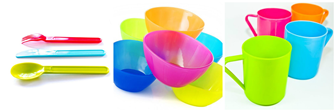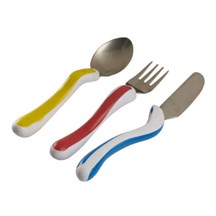 Eating Meals
Eating MealsChildren begin to develop self-feeding skills from birth. Whether your baby is breast fed or formula fed that is all they need for around the first 6 months of their lives. From around 6 months you and your baby will start the exciting journey towards healthy eating. It will be a messy journey with lots of ups and downs along the way to adulthood.
 For lots of children, meal times can be a frustrating and messy experience. Many children find it particularly difficult to co-ordinate the use of a knife and fork. This can impact on your child's confidence. As with handwriting, good positioning at the table is important. Ensure your child sits tucked into the table, with feet supported (use a footrest if necessary), and back against the chair.
For lots of children, meal times can be a frustrating and messy experience. Many children find it particularly difficult to co-ordinate the use of a knife and fork. This can impact on your child's confidence. As with handwriting, good positioning at the table is important. Ensure your child sits tucked into the table, with feet supported (use a footrest if necessary), and back against the chair.
By 5 years a child is learning to spread and cut with a knife. It is often not until they are around 7 years of age that a child can use a knife and fork together to cut up food and are truly independent with self-feeding.
Here are videos with some hints and tips for using a knife and fork together.
 Eating is an experience which involves all of our senses. It is important to understand that we all process sensory information differently. What smells good to one person can be unpleasant to others. What feels comfortably warm to some may feel too hot for others. Children who refuse foods or have a very restricted diet are dealing with a lot of information. However for some children, there appears not to be a sensory element restricting their diet, and it is their dislike of change and preference for sameness that contributes to issues around food.
Eating is an experience which involves all of our senses. It is important to understand that we all process sensory information differently. What smells good to one person can be unpleasant to others. What feels comfortably warm to some may feel too hot for others. Children who refuse foods or have a very restricted diet are dealing with a lot of information. However for some children, there appears not to be a sensory element restricting their diet, and it is their dislike of change and preference for sameness that contributes to issues around food.
 Routine
RoutineHaving a set routine for mealtimes can help children be prepared, and helps develop organisational and independence skills.
Limiting Distractions – especially if mealtimes are your family 'catch up' time, reduce background noise by turning the TV off, closing doors, curtains etc.
Where possible have set routines for all meals breakfast, dinner etc. This helps your child to understand what is going to happen and that it has an end. You can use a timer to help your child know when they can leave the table. Encouraging them to ask to leave the table helps develop good manners too.
Involve your child as much as possible. Depending on their age and stage you can get them to help set the table or do the dishes (starting with plastic plates first!).
Give your child part of the routine to be responsible for.
 It is important to consider where you child sits to eat. It affects their stability and balance to allow them to use their hands effectively, just as it does for writing. Otherwise we put a lot of effort into sitting and this can distract (even subconsciously) from what we are trying to do. It also impacts on the social aspects of meal times, as well as the skill development. For many busy families today mealtimes can be a great time to catch up on everyone’s news; it is a good way to help your child learn the social skills of sharing and listening to others.
It is important to consider where you child sits to eat. It affects their stability and balance to allow them to use their hands effectively, just as it does for writing. Otherwise we put a lot of effort into sitting and this can distract (even subconsciously) from what we are trying to do. It also impacts on the social aspects of meal times, as well as the skill development. For many busy families today mealtimes can be a great time to catch up on everyone’s news; it is a good way to help your child learn the social skills of sharing and listening to others.
 There are a number of options for helping your child with eating meals.
There are a number of options for helping your child with eating meals.
When teaching a new skill we often start at the beginning. This can be challenging for children who are struggling to master a skill. One way of learning a new task while giving your child a sense of achievement is to use the backward chaining technique. Backward chaining has been found to be particularly useful when learning self-care skills. It can also be helpful when teaching younger children and those who have difficulty learning new skills.
 So what is backward chaining? You start by breaking the task down into small steps. You teach your child the last step first, working backward from the goal. You complete all of the steps except the last one and have your child practice the final step. Your child will enjoy the success that comes from completing a task. Once your child has mastered the last step you complete all of the steps except for the last two. You teach your child the second from last step and they then complete the last step themselves. Even more success! You continue like this until you are teaching the first step and your child is completing all the other steps.
So what is backward chaining? You start by breaking the task down into small steps. You teach your child the last step first, working backward from the goal. You complete all of the steps except the last one and have your child practice the final step. Your child will enjoy the success that comes from completing a task. Once your child has mastered the last step you complete all of the steps except for the last two. You teach your child the second from last step and they then complete the last step themselves. Even more success! You continue like this until you are teaching the first step and your child is completing all the other steps.
This is a particularly useful technique to use when teaching a child how to use cutlery.